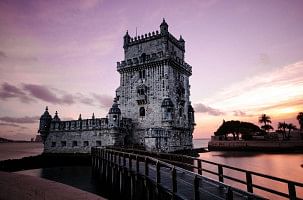Plaza de Espana Travel Guide
Plaza de Espana is a majestic square located in Seville, Spain. Built for the Ibero-American Exposition in 1929, this iconic landmark features stunning architecture, intricate tile work, and a canal that runs through the center. The square is steeped in history and culture, making it a must-visit destination for travelers seeking to immerse themselves in the beauty of Spain.Top Attractions in Plaza de Espana
- Magnificent Architecture of the Plaza de Espana building
- Boat rides along the canal
- Exploring the intricate ceramic tile work
- Visiting the nearby Maria Luisa Park
- Immersing in the cultural exhibitions at the square
Plaza de Espana is Famous for
Its exquisite architecture and beautiful tile work.Top Attractions in Plaza de Espana
- Marvel at the grandeur of Plaza de Espana building
- Take a boat ride along the canal
- Admire the intricate ceramic tile decorations
- Relax and enjoy the greenery at Maria Luisa Park
- Experience the vibrant culture through exhibitions and events
What's Great about Travelling to Plaza de Espana?
- Perfect for history buffs and architecture enthusiasts
- Ideal for travelers looking to immerse in Spanish culture
- Great for photography enthusiasts capturing stunning shots
What's Not So Great about Travelling to Plaza de Espana?
- May not be suitable for travelers looking for off-the-beaten-path destinations
- Not recommended for those seeking adrenaline-pumping activities
- Can be crowded during peak tourist seasons
Travel Tips for Plaza de Espana
- Visitors should wear comfortable shoes for exploring the large square
- Check the weather forecast as outdoor activities are popular
- Respect the historical significance of the site and follow local regulations
Important Plaza de Espana trip information
- Ideal Duration: Spend at least half a day to fully explore the square and its surroundings
- Best Time to Visit: Spring and fall offer pleasant weather for outdoor activities
- Nearby Airports and Railway Stations: Seville Airport is the closest airport, with Santa Justa train station nearby
Per Person
3,60,000
*EXCLUDING APPLICABLE TAXES 5.0 Ratings
( 57 Reviews )
( 57 Reviews )
Per Person
60,518
*EXCLUDING APPLICABLE TAXES 4.9 Ratings
( 200 Reviews )
( 200 Reviews )
Per Person
1,09,989
*EXCLUDING APPLICABLE TAXES 4.9 Ratings
( 200 Reviews )
( 200 Reviews )
FAQ's on Plaza de Espana
Q1: What is the best time to visit Plaza de Espana?
The best time to visit Plaza de Espana is during the spring (March to May) and fall (September to November) when the weather is mild, and the crowds are smaller. These seasons offer comfortable temperatures for exploring the city and enjoying outdoor activities. Additionally, visiting during off-peak months can help you avoid the peak tourist season and long lines at popular attractions.
Q2: Do I need a visa to travel to Plaza de Espana?
Travelers from many countries, including the US, Canada, the UK, and the EU, do not need a visa for short visits to Spain, which includes Plaza de Espana. However, it is essential to check the specific visa requirements based on your nationality and the duration of your stay. Ensure your passport is valid for at least six months beyond your planned departure date.
Q3: What are the must-visit attractions in Plaza de Espana?
Plaza de Espana is a must-visit attraction in itself, known for its stunning architecture and historical significance. Other top attractions in Spain include the Sagrada Familia in Barcelona, Alhambra in Granada, Park Guell, and the Prado Museum in Madrid. Don't miss exploring the vibrant neighborhoods of Seville, sampling delicious tapas, and experiencing flamenco performances for a true taste of Spanish culture.
Q4: Is Plaza de Espana a safe place to travel?
Plaza de Espana is generally a safe destination for travelers. However, like any other city, it is essential to be cautious of pickpocketing and petty crimes, especially in crowded tourist areas. Avoid walking alone at night in unfamiliar neighborhoods and always keep your belongings secure. It is advisable to stay informed about local news and follow any safety guidelines provided by authorities during your visit.
Q5: What is the local currency in Plaza de Espana and can I use credit cards?
The local currency in Spain is the Euro (€). Credit cards are widely accepted in most establishments, including hotels, restaurants, and shops. However, it is recommended to carry some cash for smaller purchases and transactions, especially in markets or local stores. ATMs are readily available in major cities for convenient currency exchange. Notify your bank before traveling to Spain to avoid any issues with using your credit or debit cards abroad.
Q6: What is the local cuisine like in Plaza de Espana?
Spanish cuisine is diverse and flavorful, known for its use of fresh ingredients and Mediterranean influences. Some popular dishes to try in Plaza de Espana include paella, tapas (small plates), gazpacho (cold tomato soup), churros con chocolate (fried dough with chocolate sauce), and jamón ibérico (cured ham). Seafood lovers will enjoy fresh seafood dishes along the coastal regions. Vegetarians and vegans will also find a variety of options, such as patatas bravas (spicy potatoes) and escalivada (grilled vegetables). Don't forget to pair your meals with local wines or sangria for an authentic dining experience.
Q7: What transportation options are available in Plaza de Espana?
Plaza de Espana offers excellent transportation options for travelers, including an efficient metro system, buses, and taxis. The metro is a convenient way to navigate major cities like Madrid and Barcelona, with extensive coverage and frequent trains. Buses are another cost-effective option for getting around, especially for longer distances or reaching destinations not accessible by metro. Taxis are widely available and can be hailed on the street or booked through apps. For exploring the countryside or neighboring cities, consider renting a car for flexibility and convenience. Additionally, biking and walking are great ways to explore the charming streets and historic sites in Plaza de Espana.
Q8: Are there any cultural norms or etiquette I should be aware of when visiting Plaza de Espana?
When visiting Plaza de Espana, it is essential to respect local customs and etiquette. Spaniards are known for their warm hospitality and strong sense of family and community. Greetings are important, so be sure to greet people with a handshake or two kisses on the cheek, depending on the region. Dining etiquette includes waiting for the host to start the meal and keeping your hands visible on the table. Tipping is common in restaurants, usually around 5-10% of the total bill. When visiting religious sites or monuments, dress modestly and avoid loud behavior out of respect. Learning a few basic Spanish phrases can also enhance your experience and show appreciation for the local culture.
Q9: I am a travel agent. How can I buy travel leads of Plaza de Espana?
Register yourself as a travel agent at agents.tripclap.com and then you can buy travel leads to Plaza de Espana once your account is approved. For more details contact our support team at +91-8069186564 or support@tripclap.com



